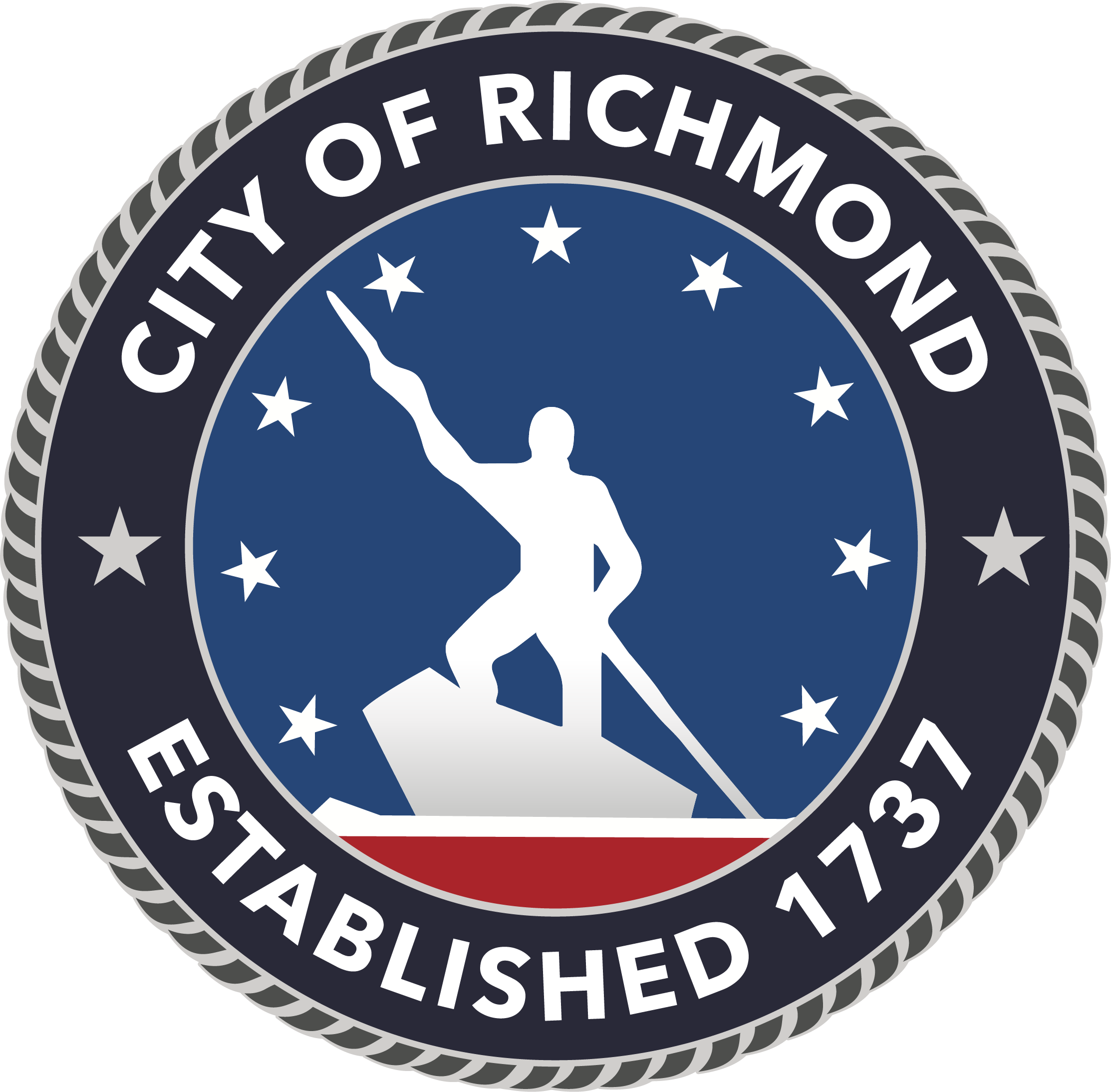UPDATE: Advisory Lifted
City of Richmond Update to Tredegar Pipeline Trail Pipe Repair
August 1, 2024
The Virginia Department of Health (VDH) is lifting the recreational water advisory for the James River beginning at the Manchester Bridge (9th Street) in the City of Richmond and ending at Osborne Landing in Henrico County. The advisory was issued July 17, due to a sewer release near the Pipeline Trail, along the James River.
The City has met regularly with the Department of Environmental Quality (DEQ) and VDH since this incident, and DEQ and VDH have been actively monitoring the situation. Water quality sampling results collected by DEQ on July 29 and July 30, indicate bacteria concentrations in the James River in the prior advisory area are at levels acceptable for all recreational water use.
The City of Richmond continues to address the 42” failed pipe at the Tredegar Pipeline, which is a combined sewer system pipe. Long term and short-term actions include the following:
- Installation of two large 42” inflatable plugs [COMPLETED]
- The plugs are designed to close off segments of the sewer line from any flow while repairs are taking place.
- Both plugs have been installed.
- Temporary patching to the impacted areas of the pipe [COMPLETED]
- Consisting of epoxy and steel plates which are designed to seal all leakage points.
- The temporary patch installations are complete.
- Isolation of the damaged line segment to prevent any additional flow into the pipe [IN PROGRESS]
- A welder was onsite July 18, 2024 to assess the feasibility of a more permanent option. The assessment identified the solution to install metal flanges, which will be welded in place to completely isolate both ends of the pipe.
- This work will begin the week of August 5, 2024.
The longer-term and more permanent solution requires an in-depth engineering design and coordination process as this 42” pipe is elevated above the river, where access and the ability to mobilize repair crews is a challenge.
The City of Richmond is an old city with aged infrastructure. The Department of Public Utilities is responsible for a territory which includes 5,000 miles of water, sewer and gas pipes as well as 200,000+ other assets (i.e. fire hydrants, meters, valves). Condition assessments help to inform repair, rehabilitation and replacement schedules.
Residents, businesses and visitors rely upon the James River as a water supply source, an economic driver and a recreational resource. The City continues to undertake significant construction projects to protect and preserve the James River while partnering with stakeholders to help identify and prioritize ways to enhance the river.
VDH Lifts Recreational Water Advisory for the James River - Newsroom (virginia.gov)
July 24, 2024
The City of Richmond continues to work with the Department of Environmental Quality (DEQ) regarding two isolated events which occurred during July 2024 at the Tredegar Pipeline Trail. These are two separate incidents and not a continual leak. Initial investigation showed that the first leak on July 2 was related to a wet weather event and was exacerbated by a stormwater connection from an adjacent commercial property. The City reported this to DEQ within 24 hours as required. The City of Richmond Department of Public Utilities confirmed there were no leaks on July 3. There were also no citizen reports of the pipe leaking for the two weeks between the two incidents. The July 2 incident has been closed by DEQ.
The second incident was reported to the City on July 15, and the city immediately responded. The repairs are ongoing and the updates are outlined below.
The Department of Environmental Quality and Virginia Department of Health (VDH) continue to monitor the impacts to the river. Sampling will continue to determine when the Recreational Water Advisory for the James River from Manchester Bridge to Osborne Landing will be lifted by VDH, when VDH determines bacteria levels are acceptable for recreational contact. The City is meeting regularly with DEQ and VDH to continue collaborative conversations regarding repairs.
Repair Updates
The City of Richmond continues to address the 42” failed pipe at the Tredegar Pipeline, which is a combined sewer system pipe. Long term and short-term actions include the following:
- Installation of two large 42” inflatable plugs
- The plugs are designed to close off segments of the sewer line from any flow while repairs are taking place.
- Installation of the large inflatable plugs started July 18, 2024 and one plug was successfully installed. Installation of the second plug is in process.
- A temporary patch to the impacted area of the pipe (i.e. under the belly of)
- Consisting of epoxy and steel plates which are designed to seal all leakage points.
- This work began Monday, July 22, 2024 and has been challenging as crews have had to consider workarounds based on the location and complexity of the impacted area.
- Isolation of the damaged line segment to prevent any additional flow into the pipe
- A welder was onsite July 18, 2024 to assess the feasibility of a more permanent option. The assessment identified the solution to install metal flanges, which will be welded in place to completely isolate both ends of the pipe. This work is expected to begin the first week of August 2024.
The longer-term and more permanent solution requires an in-depth engineering design and coordination as this 42” pipe is elevated above the river, where access and the ability to mobilize repair crews is a challenge.
The City of Richmond is an old city with aged infrastructure. The Department of Public Utilities is responsible for a territory which includes 5,000 miles of water, sewer and gas pipes as well as 200,000+ other assets (i.e. fire hydrants, meters, valves). Condition assessments help to inform repair, rehabilitation and replacement schedules.
July 17, 2024
The Virginia Department of Health (VDH) issued a recreational water advisory for the James River beginning at the Manchester Bridge (9th Street) in the City of Richmond to Osborne Landing in Henrico County. For the safety of people and pets, VDH is advising that recreational water activities, such as swimming, wading, tubing, and whitewater kayaking (where submersion in the water is likely), should be avoided.
The City of Richmond’s drinking water is upstream from the impacted site and is not impacted.
This advisory is being released out of an abundance of caution due to a leak in a sewage pipe on the Pipeline Trail, which was reported on July 16. City crews joined with the Department of Environmental Quality (DEQ), immediately responded to assess the site, and performed testing which confirmed high levels of bacteria. Investigation revealed that a bypass pumps had gone off-line. Crews were able to re-establish the bypass pumping operation to remove all flow from the pipe thereby severely diminishing the sewage release. Repairs of this 42” pipe will begin within the next 24 hours. Repairs include installation of large inflatable plugs, isolation of the damaged line segment to prevent any additional flow, and a temporary patch to the impacted area of the pipe. The City believes this immediate response will eliminate further impacts to the river. The long-term solution requires more in-depth design and coordination as this 42” pipe is elevated above the river, where access is a challenge.
Signage has been installed at the public access points. Public access points to the James River in the impacted area include Great Shiplock Park and Chapel Island, 14th Street Takeout, Dock Street Park, Wharf Street / Intermediate Terminal, Ancarrow’s Landing, and Osborne Landing.
 FAQs
FAQs
As a City of Richmond resident, should I be concerned about my drinking water?
No. The City of Richmond’s drinking water source is not impacted. Drinking water samples continue to meet Virginia Department of Health (VDH) standards.
Should I swim in the river?
Not until the advisory is lifted. Recreational water activities, such as swimming, wading, tubing, and whitewater kayaking (where submersion in the water is likely), should be avoided. However, activities, which are not likely to result in water submersion (boating, fishing, canoeing), may continue with proper caution to avoid contact with the water.
Why did this happen?
The pipe has been identified as being put into service over 50 years ago and is further environmentally compromised based on its exposure to the elements and its location – which is suspended above the river.
What is the City doing to prevent this from happening in the short-term?
The City is working with a contractor for both temporary and permanent repairs. The temporary repairs include installation of large inflatable plugs, isolation of the damaged line segment to prevent any additional flow, and the service of a welder to create a temporary patch to the impacted area of the pipe.
What is the City doing to prevent this from happening in the long-term?
The long-term solution requires an in-depth engineering design and coordination as this 42” pipe is elevated above the river, where access is a challenge.







